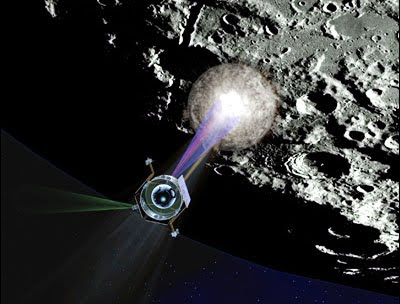CHANDRAYAAN-1 discovers Millions of tonnes of ice on the moon.

CHANDRAYAAN-1’s momentous discoveries of water on the moon in different forms do not seem to end. In its latest discovery, the third so far, the spacecraft’s radar called Miniature-Synthetic Aperture Radar (Mini-SAR) has found more than 40 craters in the moon with ice deposits.
The craters vary from two kilometres to 15 km in diameter. They are situated in the North Pole, in the permanently shadowed regions of the moon. The National Aeronautics and Space Administration (NASA) estimated that there could be at least 600 million tonnes of water ice in these craters.
The Mini-SAR is a NASA instrument that flew on board Chandrayaan-1, which lifted off from the spaceport at Sriharikota in Andhra Pradesh on October 22, 2008. The spacecraft carried 11 scientific instruments from different countries, including India. This is the second NASA instrument on board Chandrayaan-1 to discover water on the moon.
Earlier, the Moon Mineralogy Mapper (M3) detected water molecules in extremely minute quantities on the moon’s surface soil and rocks. An Indian instrument called Chandra’s Altitudinal Composition Explorer (ChACE), which is a mass spectrometer and was housed in the Moon Impact Probe (MIP), also obtained “very clear signatures of H{-2}0 (18 atomic mass unit, or amu) intensifying” in the thin atmosphere of the moon. The MIP crashed on the lunar surface on November 14, 2008 (Frontline, October 23, 2009).
Prof. Paul Spudis, Principal Investigator of the Mini-SAR experiment at the Lunar and Planetary Institute, Houston, United States, said: “The new discoveries by Chandrayaan-1 and other lunar missions show that the moon is an even more interesting and attractive scientific exploration and operational destination than people had previously thought.”
J.N. Goswami, Principal Scientist, Chandrayaan-1, called the latest discovery “an interesting and new result”. He was confident that whatever signals the scientists were getting about the presence of ice deposits in the craters were correct. “It is quite interesting from our perspective. We thought it would be there and it is there,” he said.
Prof. Goswami, who is also Director, Physical Research Laboratory, Ahmedabad, pointed out that the M3 had earlier found water molecules on the moon’s surface soil and rocks. “We are now finding it in solid form. So this is very important. Water is an important resource if people want to go to the moon,” he said.
The latest discovery presaged a “positive direction for future explorations with respect to lunar resources and pursuit of pure science”, said Mylswami Annadurai, Project Director, Chandrayaan-1 and 2. “Earlier, we had seen the physical phenomenon of water getting formed in one region of the moon. We are now seeing water getting retained in another region as ice deposits. This is called volatile transportation,” he added.
Spudis said, “The emerging picture from the multiple measurements and resulting data of the instruments on lunar missions indicates that water creation, migration, deposition and retention are occurring on the moon.” The new findings have added to the growing scientific understanding of the multiple forms of water on the moon.
Annadurai is happy that the three important discoveries were made by Chandrayaan-1’s instruments. “These discoveries indicate that we had a good combination of instruments on board Chandrayaan-1. They could not have been made by optical instruments, which need sunlight to see what is there,” explained Annadurai.
For instance, the Mini-SAR mapped the moon’s permanently shadowed polar craters, which are not visible from the earth. The radar uses the polarisation properties of reflected radio waves to characterise surface properties. Results from the mapping showed deposits having radar characteristics similar to ice.
In the estimate of S. Satish, the spokesman for the Indian Space Research Organisation (ISRO), the discovery had significant implications for undertaking future missions to the moon and for interplanetary travel.
The amount of ice estimated to be present in the craters held promise for establishing colonies on the moon, he said. He also said, “The ice can be used for production of oxygen for sustaining the astronauts’ stay in the moon and to provide water to their habitat.” He predicted that future missions would concentrate on landing rovers near the craters so that an accurate estimate of the amount of ice available in them could be had.
However, a scientist of the Space Physics Laboratory (SPL), Vikram Sarabhai Space Centre, Thiruvananthapuram, cautioned that it would be extremely difficult to set up human colonies in these permanently shadowed regions of the moon’s North Pole. While lunar explorations with more orbiters, landers and rovers would get a boost with these discoveries, it was premature to talk of establishing human colonies, he said.
The craters vary from two kilometres to 15 km in diameter. They are situated in the North Pole, in the permanently shadowed regions of the moon. The National Aeronautics and Space Administration (NASA) estimated that there could be at least 600 million tonnes of water ice in these craters.
The Mini-SAR is a NASA instrument that flew on board Chandrayaan-1, which lifted off from the spaceport at Sriharikota in Andhra Pradesh on October 22, 2008. The spacecraft carried 11 scientific instruments from different countries, including India. This is the second NASA instrument on board Chandrayaan-1 to discover water on the moon.
Earlier, the Moon Mineralogy Mapper (M3) detected water molecules in extremely minute quantities on the moon’s surface soil and rocks. An Indian instrument called Chandra’s Altitudinal Composition Explorer (ChACE), which is a mass spectrometer and was housed in the Moon Impact Probe (MIP), also obtained “very clear signatures of H{-2}0 (18 atomic mass unit, or amu) intensifying” in the thin atmosphere of the moon. The MIP crashed on the lunar surface on November 14, 2008 (Frontline, October 23, 2009).
Prof. Paul Spudis, Principal Investigator of the Mini-SAR experiment at the Lunar and Planetary Institute, Houston, United States, said: “The new discoveries by Chandrayaan-1 and other lunar missions show that the moon is an even more interesting and attractive scientific exploration and operational destination than people had previously thought.”
J.N. Goswami, Principal Scientist, Chandrayaan-1, called the latest discovery “an interesting and new result”. He was confident that whatever signals the scientists were getting about the presence of ice deposits in the craters were correct. “It is quite interesting from our perspective. We thought it would be there and it is there,” he said.
Prof. Goswami, who is also Director, Physical Research Laboratory, Ahmedabad, pointed out that the M3 had earlier found water molecules on the moon’s surface soil and rocks. “We are now finding it in solid form. So this is very important. Water is an important resource if people want to go to the moon,” he said.
The latest discovery presaged a “positive direction for future explorations with respect to lunar resources and pursuit of pure science”, said Mylswami Annadurai, Project Director, Chandrayaan-1 and 2. “Earlier, we had seen the physical phenomenon of water getting formed in one region of the moon. We are now seeing water getting retained in another region as ice deposits. This is called volatile transportation,” he added.
Spudis said, “The emerging picture from the multiple measurements and resulting data of the instruments on lunar missions indicates that water creation, migration, deposition and retention are occurring on the moon.” The new findings have added to the growing scientific understanding of the multiple forms of water on the moon.
Annadurai is happy that the three important discoveries were made by Chandrayaan-1’s instruments. “These discoveries indicate that we had a good combination of instruments on board Chandrayaan-1. They could not have been made by optical instruments, which need sunlight to see what is there,” explained Annadurai.
For instance, the Mini-SAR mapped the moon’s permanently shadowed polar craters, which are not visible from the earth. The radar uses the polarisation properties of reflected radio waves to characterise surface properties. Results from the mapping showed deposits having radar characteristics similar to ice.
In the estimate of S. Satish, the spokesman for the Indian Space Research Organisation (ISRO), the discovery had significant implications for undertaking future missions to the moon and for interplanetary travel.
The amount of ice estimated to be present in the craters held promise for establishing colonies on the moon, he said. He also said, “The ice can be used for production of oxygen for sustaining the astronauts’ stay in the moon and to provide water to their habitat.” He predicted that future missions would concentrate on landing rovers near the craters so that an accurate estimate of the amount of ice available in them could be had.
However, a scientist of the Space Physics Laboratory (SPL), Vikram Sarabhai Space Centre, Thiruvananthapuram, cautioned that it would be extremely difficult to set up human colonies in these permanently shadowed regions of the moon’s North Pole. While lunar explorations with more orbiters, landers and rovers would get a boost with these discoveries, it was premature to talk of establishing human colonies, he said.




























0 comments:
Post a Comment
We encourage people to contact us with any comments regarding news or any other queries about this site. We will respond you respectively and promptly.
We are going to moderate comments only to avoid unwanted and spam messages.
Thanks for your interest ! ! ! ! ! ! !